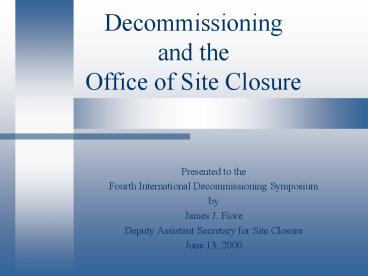Decommissioning and the Office of Site Closure - PowerPoint PPT Presentation
1 / 15
Title:
Decommissioning and the Office of Site Closure
Description:
Near term - achieving site closure at Fernald, Rocky Flats, and Mound by 2006 ... After some near-term site closures, emphasis will shift to decommissioning ... – PowerPoint PPT presentation
Number of Views:84
Avg rating:3.0/5.0
Title: Decommissioning and the Office of Site Closure
1
Decommissioning and the Office of Site Closure
- Presented to the
- Fourth International Decommissioning Symposium
- by
- James J. Fiore
- Deputy Assistant Secretary for Site Closure
- June 13, 2000
2
International Decommissioning Symposium
- WELCOME
- to the
- Fourth International
- Decommissioning
- Symposium
3
International Decommissioning Symposium
- Why did the Office of Site Closure sponsor this
symposium? - We have a large inventory of nuclear facilities
that will ultimately require decommissioning - Where are the remaining decommissioning
challenges? - Near term - achieving site closure at Fernald,
Rocky Flats, and Mound by 2006 - Longer term - the huge inventory of facilities
remaining within the Office of Site Closure and
the Office of Project Completion
4
EM Decommissioning - Scope
- Albuquerque
- 184 facilities total 69 completed
- Chicago
- 85 facilities total 50 completed
- Idaho
- 298 facilities total 107 completed
5
EM Decommissioning - Scope
- Nevada
- 7 facilities total 2 completed
- Oak Ridge
- 231 facilities total 69 completed
- Oakland
- 41 facilities total 3 completed
6
EM Decommissioning - Scope
- Ohio
- 161 facilities total 37 completed
- Richland
- 1265 facilities total 52 completed
- Rocky Flats
- 774 facilities total 59 completed
7
Office of Site Closure - Vision
- Set the standard for safe, cost-effective closure
of nuclear facilities - Be the model for transitioning Government
activities from operations to closure - Achieve end-states that are safe now and enable
protective, effective stewardship for the future
8
Office of Site Closure - Vision
- Deploy new technologies to help the drive toward
closure - Focus on closing sites under our responsibility
by 2006
9
Achieving the Vision
- General Approach
- More effective information exchange with industry
- More demonstrations/deployments that result in
facilities being decommissioned - Focus on
- Increasing worker safety
- Reducing worker exposures
- Saving time and money
10
The Near-Term Decommissioning Outlook
- Our current and near-term emphasis is on soil and
groundwater remediation - In spite of tight budgets, remediation work must
grow at some sites - Our total budget will likely remain flat
- After some near-term site closures, emphasis
will shift to decommissioning
11
The Near-Term Decommissioning Outlook
- How will we ensure we are ready when we begin
decommissioning? We must - Ensure we learn from every decommissioning we
undertake - Maximize information sharing
- Improve our performance through better
sequencing, more efficient operations, and
enhanced cooperation among our sites and between
DOE and the regulators
12
The Near-Term Decommissioning Outlook
- When our focus shifts, we will need to hit the
ground running - Success will require more cost-effective
deactivation and decommissioning
13
Near-Term Efficiency Goals
- Learn from other sites, agencies, and countries
and apply those lessons to our program - See our Lessons Learned web site at
- http//www.em.doe.gov/lessons
- Improve decommissioning practices to yield safer,
more effective, faster results
14
Achieving Near-Term Efficiency Goals
- What are we doing to achieve these goals?
- Learning from and contracting with companies who
have successfully decommissioned facilities
similar to ours - Consolidating responsibility within a single
decommissioning contractor to ensure
accountability and authority - Encouraging subcontracting to reduce overhead
costs
15
Conclusion
- The decommissioning challenge facing the Office
of Site Closure is formidable - We believe we are on a path (and have identified
opportunities for improvement) that will enable
us to meet the challenge - Thank you for your participation in our program
and this symposium - we could not do it without
you






























